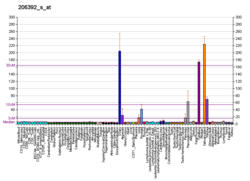RARRES1
Protein-coding gene in the species Homo sapiens
| RARRES1 | |||||||||||||||||||||||||||||||||||||||||||||||||||
|---|---|---|---|---|---|---|---|---|---|---|---|---|---|---|---|---|---|---|---|---|---|---|---|---|---|---|---|---|---|---|---|---|---|---|---|---|---|---|---|---|---|---|---|---|---|---|---|---|---|---|---|
| Identifiers | |||||||||||||||||||||||||||||||||||||||||||||||||||
| Aliases | RARRES1, LXNL, TIG1, PERG-1, retinoic acid receptor responder 1 | ||||||||||||||||||||||||||||||||||||||||||||||||||
| External IDs | OMIM: 605090; MGI: 1924461; HomoloGene: 2166; GeneCards: RARRES1; OMA:RARRES1 - orthologs | ||||||||||||||||||||||||||||||||||||||||||||||||||
| |||||||||||||||||||||||||||||||||||||||||||||||||||
| |||||||||||||||||||||||||||||||||||||||||||||||||||
| |||||||||||||||||||||||||||||||||||||||||||||||||||
| |||||||||||||||||||||||||||||||||||||||||||||||||||
| |||||||||||||||||||||||||||||||||||||||||||||||||||
| Wikidata | |||||||||||||||||||||||||||||||||||||||||||||||||||
| |||||||||||||||||||||||||||||||||||||||||||||||||||
Retinoic acid receptor responder protein 1 is a protein that in humans is encoded by the RARRES1 gene.[5][6][7]
This gene was identified as a retinoid acid (RA) receptor-responsive gene. It encodes a type 1 membrane protein. The expression of this gene is upregulated by tazarotene as well as by retinoic acid receptors. The expression of this gene is found to be downregulated in prostate cancer, which is caused by the methylation of its promoter and CpG island. Alternatively spliced transcript variant encoding distinct isoforms have been observed.[7]
References
- ^ a b c GRCh38: Ensembl release 89: ENSG00000118849 – Ensembl, May 2017
- ^ a b c GRCm38: Ensembl release 89: ENSMUSG00000049404 – Ensembl, May 2017
- ^ "Human PubMed Reference:". National Center for Biotechnology Information, U.S. National Library of Medicine.
- ^ "Mouse PubMed Reference:". National Center for Biotechnology Information, U.S. National Library of Medicine.
- ^ Nagpal S, Patel S, Asano AT, Johnson AT, Duvic M, Chandraratna RA (May 1996). "Tazarotene-induced gene 1 (TIG1), a novel retinoic acid receptor-responsive gene in skin". J Invest Dermatol. 106 (2): 269–74. doi:10.1111/1523-1747.ep12340668. PMID 8601727.
- ^ Duvic M, Nagpal S, Asano AT, Chandraratna RA (Sep 1997). "Molecular mechanisms of tazarotene action in psoriasis". J Am Acad Dermatol. 37 (2 Pt 3): S18–24. doi:10.1016/s0190-9622(97)80396-9. PMID 9270552.
- ^ a b "Entrez Gene: RARRES1 retinoic acid receptor responder (tazarotene induced) 1".
Further reading
- Jing C, El-Ghany MA, Beesley C, et al. (2002). "Tazarotene-induced gene 1 (TIG1) expression in prostate carcinomas and its relationship to tumorigenicity". J. Natl. Cancer Inst. 94 (7): 482–90. doi:10.1093/jnci/94.7.482. PMID 11929948.
- Strausberg RL, Feingold EA, Grouse LH, et al. (2003). "Generation and initial analysis of more than 15,000 full-length human and mouse cDNA sequences". Proc. Natl. Acad. Sci. U.S.A. 99 (26): 16899–903. Bibcode:2002PNAS...9916899M. doi:10.1073/pnas.242603899. PMC 139241. PMID 12477932.
- Zhang J, Liu L, Pfeifer GP (2004). "Methylation of the retinoid response gene TIG1 in prostate cancer correlates with methylation of the retinoic acid receptor beta gene". Oncogene. 23 (12): 2241–9. doi:10.1038/sj.onc.1207328. PMID 14691453.
- Youssef EM, Chen XQ, Higuchi E, et al. (2004). "Hypermethylation and silencing of the putative tumor suppressor Tazarotene-induced gene 1 in human cancers". Cancer Res. 64 (7): 2411–7. doi:10.1158/0008-5472.CAN-03-0164. PMID 15059893.
- Gerhard DS, Wagner L, Feingold EA, et al. (2004). "The status, quality, and expansion of the NIH full-length cDNA project: the Mammalian Gene Collection (MGC)". Genome Res. 14 (10B): 2121–7. doi:10.1101/gr.2596504. PMC 528928. PMID 15489334.
- Mizuiri H, Yoshida K, Toge T, et al. (2005). "DNA methylation of genes linked to retinoid signaling in squamous cell carcinoma of the esophagus: DNA methylation of CRBP1 and TIG1 is associated with tumor stage". Cancer Sci. 96 (9): 571–7. doi:10.1111/j.1349-7006.2005.00082.x. PMC 11159114. PMID 16128742. S2CID 39812145.
- Shutoh M, Oue N, Aung PP, et al. (2006). "DNA methylation of genes linked with retinoid signaling in gastric carcinoma: expression of the retinoid acid receptor beta, cellular retinol-binding protein 1, and tazarotene-induced gene 1 genes is associated with DNA methylation". Cancer. 104 (8): 1609–19. doi:10.1002/cncr.21392. PMID 16134180. S2CID 43346140.
- v
- t
- e



















